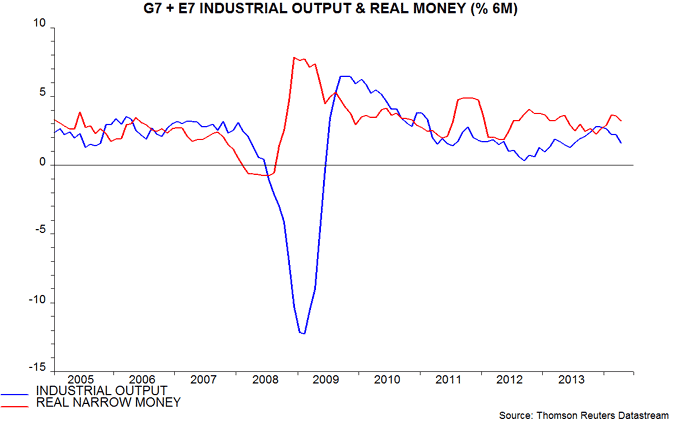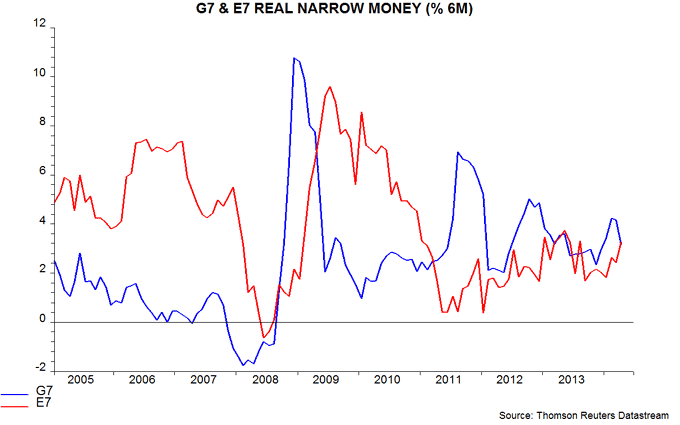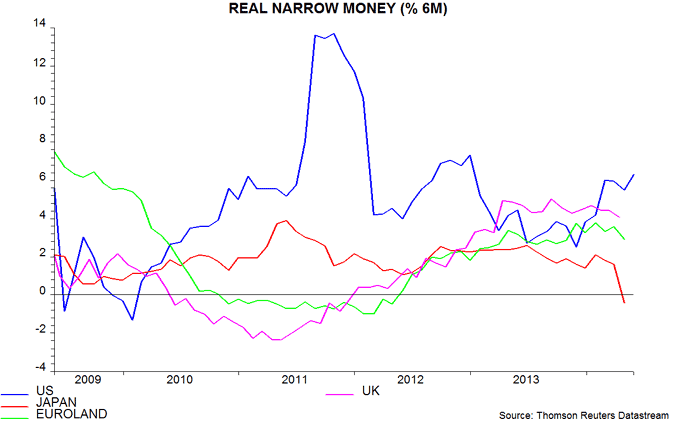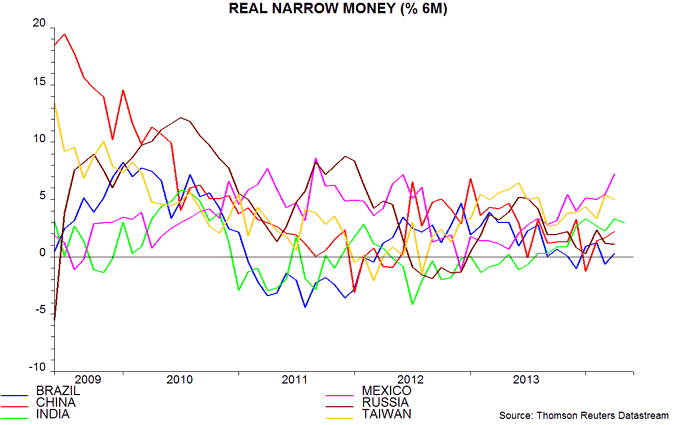Entries from June 1, 2014 - June 7, 2014
UK MPC still underestimating labour market strength
The MPC lowered its unemployment rate projections again in the May Inflation Report but is probably still underestimating the speed of decline. The jobless rate may end 2014 at or below 6.0%, i.e. close to the MPC’s current central estimate of non-inflationary “medium-term equilibrium” of 5.8%.
The unemployment rate fell from 7.8% to 6.8% in the year to the first quarter of 2014 as GDP grew by 3.1%. The MPC expects GDP expansion to remain at 3.0-3.25% annualised through the fourth quarter. This suggests that the jobless rate will continue to decline by 0.25 percentage points (pp) per quarter, implying 6.0% by year-end.
The MPC, by contrast, forecasts that the quarterly fall will slow to 0.15 pp, yielding a 6.3% unemployment rate by the fourth quarter. This rests on an assumption that productivity growth will start to “mean revert” as the expansion matures. The same assumption was made in the February and November Inflation Reports but little recovery is yet evident. This is consistent with experience after the last major productivity “shock” in the 1970s, when performance remained weak for many years – see previous post.
Hopes of near-term productivity improvement are not supported by labour market leading indicators, which have yet to suggest any slowdown in employment gains or unemployment erosion. Six-month growth of the stock of vacancies, indeed, has risen further from 8% in October to 14% in April. The PMI services employment index regained its October peak in May – a 17-year high. The net percentage of consumers expecting a rise in unemployment, meanwhile, collapsed to a 16-year low last month – see chart.
These trends imply that productivity remains stagnant or else economic growth is even stronger than expected – either possibility, of course, would warrant greater inflation concern. Pressure for an early interest rate increase may continue to build.

ECB reaction: anything but QE
The package of measures announced today by the ECB will probably have limited direct impact on money and credit conditions.
The ECB introduced new “targeted longer-term refinancing operations”, under which banks will be able to borrow from the ECB at a fixed rate for up to about four years to fund loans to the private sector, except for housing. The initial allocation of about €400 billion would allow an increase in the stock of such loans by 7%. The interest rate is fixed at the level of the main refinancing rate on take-up plus 10 basis points, i.e. only 0.25% currently. This is significantly more generous than the Bank of England’s funding for lending scheme (FLS). Unlike the initial FLS, however, it appears that banks will be required to hold additional capital against new loans. This, coupled with weak credit demand, may limit usage.
The ECB cut the main refinancing and deposit rates by 10 rather than the expected 15 basis points. It “intensified preparatory work” on buying asset-backed securities but has yet to make a formal decision to do so. The timing and size of any programme remain opaque. Decisions to extend fixed-rate full-allotment regular repos until at least end-2016, and no longer to sterilise bond purchases under the securities markets programme, were expected and are relatively insignificant.
The interest rate cuts are of net benefit to the banking system, since borrowing from the ECB significantly exceeds cash holdings. Cash-rich core banks, however, suffer at the expense of peripheral institutions with high borrowing and no excess reserves, although the amounts involved are small.
In his press conference comments, ECB President Draghi continued to dangle the carrot of an eventual US / UK-style QE programme. However, the Bundesbank’s support for today’s package, allowing Mr Draghi to trumpet a unanimous decision, may have been offered in return for keeping QE off the table for many more months.
The hope is that confidence effects from today’s announcements will be significant, while inflation will revive gradually as economic recovery continues. The latter scenario is plausible but monetary trends over the summer will be the best gauge of whether further ECB action will be required later in 2014.
UK money trends signalling further economic strength
Everyone, it seems, is positive about UK economic prospects. It is easy to be bullish when GDP has expanded solidly for four successive quarters, business surveys are strong and consumer confidence is hitting records. It was much harder in early 2013, when coincident indicators were weak and “triple dip” talk was fashionable. That was when a monetarist forecasting approach proved its worth.
The few economists who bother to examine the data know that real narrow money – specifically, non-financial M1* deflated by consumer prices – outperforms other money / lending measures as a leading indicator of the economy. This aggregate accelerated steadily through 2012 and was growing strongly by early 2013. The clear message was that the “triple dip” was nonsense and the economy would outperform expectations significantly in 2013.
So what is real narrow money signalling now? Six-month growth remains strong but has moderated in early 2014, with April’s reading the lowest since March 2013 – see chart. This suggests that GDP will continue to expand robustly through the third quarter but may slow slightly in late 2014.
Broad money, while less reliable, is also giving a benign message. Six-month growth of real non-financial M4, indeed, has moved slightly higher in 2014, though remains modest by historical standards. As previously explained, broad money trends are understating monetary laxity because falling deposit interest rates are depressing the demand to hold savings in monetary form. The velocity of circulation, in other words, is now rising**, implying that a given rate of broad money growth is more expansionary than in the past.
Credit trends contain little information about economic prospects. The six-month change in real non-financial M4 lending has recovered to zero in lagged response to faster GDP expansion. Arranged credit facilities – a leading indicator – do not suggest any imminent strong pick-up. The Bank of England, bizarrely, is considering “macroprudential” tinkering to restrict credit supply; it should focus, instead, on the inflation / asset bubble risks posed by monetary excess.
*Non-financial M1 comprises notes / coin and sterling sight deposits held by households and private non-financial firms.
**The ratio of nominal GDP to non-financial M4 (lagged six quarters) rose by 0.6% per annum between the second quarter of 2009 and the first quarter of 2014 versus a 3.2% pa decline over the prior 10 years.

Global real money growth supported by E7 recovery
Global* six-month real narrow money expansion slipped back in April but the decline was attributable to a sales-tax-driven rise in Japanese inflation. Trends elsewhere remain solid, suggesting favourable economic prospects through late 2014, allowing for the typical half-year lead.
Global six-month industrial output growth has fallen sharply from a November peak, consistent with a monetary slowdown from spring 2013 through the autumn – see first chart. Real money expansion, however, rebounded between November and February / March, signalling economic reacceleration between May and August / September.
The fall in global real money growth in April reflected the G7 component; E7 expansion, by contrast, rose to an eight-month high, suggesting improving economic and equity market prospects – second chart.
The G7 fall was mainly due to a temporary inflation-driven contraction in Japanese real money – third chart. Narrow money trends remain strong in the US and to a lesser extent the UK with the Eurozone lagging – see previous post.
Among the E7, real money growth is booming in Mexico and Taiwan but remains weak in Brazil – fourth chart. India is solid while China has recovered. Russian expansion is soft but the fall-out from the recent crisis has been smaller than expected.
*Global = G7 developed economies plus E7 emerging markets.
**May estimate included in chart.





